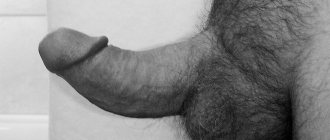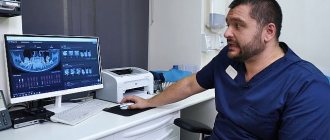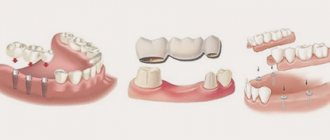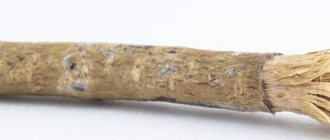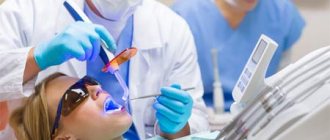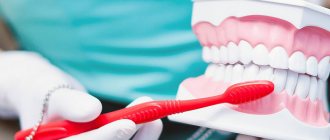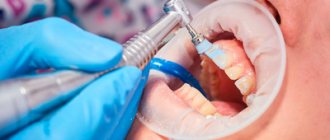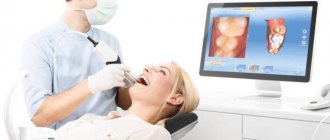At the turn of the 19th and 20th centuries, there was a rapid development of such natural sciences as chemistry, biology and physiology. This process also influenced the transformation of the dental field, which, after being combined with maxillofacial surgery, began to be called the now familiar word “dentistry”.
The main trends in the development of dentistry in the 20th century can be identified:
- The emergence and improvement of specialized areas of dentistry.
- Increasing requirements for the quality of professional training of dentists.
- Rapid improvement of equipment and technologies, creation of innovative equipment, tools and materials, achievement of the highest level of development in practical dentistry.
Already at the beginning of the 20th century, specialized areas were identified in general dentistry, which continue to develop to this day. These include:
Therapeutic dentistry
(research and diagnosis of dental diseases, as well as bone and mucous tissues of the oral cavity, search for treatment methods that maximally preserve the structure and functions of organs and systems).
Surgical dentistry
(research and diagnosis of diseases and defects of organs and tissues of the oral and maxillofacial area, search and improvement of surgical methods for their treatment).
Orthopedic dentistry
(study of violations of the integrity of teeth and jaws, deterioration of their functioning, as well as the search for methods of treatment and prevention of such defects through prosthetics).
Children's dentistry
(study of the process of formation and development of various organs and tissues in the maxillofacial and oral area in children, as well as the search and improvement of methods for diagnosing, treating and preventing various diseases, dental anomalies and defects of the jaws and mucous membranes).
Development of dentistry in Russia
Simultaneously with the process of development of dentistry as an independent medical field, the point of view that the training of dentists should be carried out at universities was becoming increasingly popular in Russia. Back in 1910, during the XI Pirogov Congress, it was decided that in all medical faculties it was necessary to establish independent dental departments, which should have technical laboratories and clinics.
As a result, in March 1920, dentistry departments began operating in all medical faculties of state universities. In addition, special institutes were opened: in 1919 - the Institute of Public Dentistry in Petrograd, the Odontological Institute in Kiev, and in 1922 - the State Institute of Dentistry in Moscow, which in 1927 became known as GISO (State Institute of Dentistry and Odontology), and later was renamed MMSI (Moscow Medical Dental Institute). In 1928, the Scientific Research Institute of Dentistry appeared in Odessa - the first research institution of this profile in the country.
In 1935, 11 dental institutes opened their doors. In 1946, the training period for dentists was increased from 4 to 5 years. The number of higher educational institutions where doctors in this specialty were trained has also increased. In total, there were 44 faculties of dentistry and 2 specialized dental institutes in the country (one of them was located in Moscow, the second in Poltava); annually, a total of 8,700 students were admitted to the first year in all educational institutions.
All of the above facts indicate that great attention was paid to the process of training dentists. However, the rapid development of dentistry in the 20th century is explained not only by the increased quality of training, but also by a sharp leap in the development of equipment and technology.
How they were treated in the Middle Ages: monks and barbers, removal and dangerous anesthesia
By the beginning of the Middle Ages, the developments of the ancient world in the field of dental treatment were almost completely lost.
Treatment and illness were associated with peculiar rituals due to the religiosity of people at that time. This led to an almost zero level of medicine. There were no doctors; their functions were taken over by the monks. There were no methods to save from toothache other than extraction, and this was often done by barbers who learned the trade at the monastery. They had a full set of instruments for surgical manipulation.
In 1210, the Guild of Hairdressers was even founded in France, in which responsibilities for healing and not only teeth were clearly distributed.
They were also involved in the removal of limbs and opening of abscesses, in fact, any surgical manipulations of that time.
It was then that the prototypes of pain relief arose, and it had a unique appearance. Most fainted at the sight of the work tools. Those with stronger nerves were hit on the head with a heavy baton. The patients lost consciousness, and the doctors carried out their manipulations.
There were also methods for removing teeth: they sat the patient on a horse and picked him up with forceps, spurring him towards the animal. After the horse jerked, the tooth flew out. But the most common was holding the patient during the procedure by assistants and forcibly removing him.
forceps
Patients who did not agree with such barbaric methods of dental treatment in ancient times were offered herbal treatments and spells.
Later, other, more effective methods appeared. So in the 14th century, a surgeon from France, Guy de Chauliac, wrote about inserting a hot needle into a carious cavity to get rid of infection. It really helped, but in a slightly different way - the nerve died and the tooth stopped bothering me.
This is how problems in the mouth were treated in the old days. Even such dentistry in the Middle Ages still helped to cope with some problems, although sometimes the methods were painful. Gradually everything began to change.
Application of technical innovations in dentistry
Already at the very beginning of the 20th century, electric drills began to be actively introduced into dental practice. Simultaneously with the invention and the start of industrial production of drills, angled and straight handpieces were created and later improved, which to this day remain the main tools of the dentist.
The improvement of drills was carried out in the direction of inventing designs that would ensure maximum rotation speed of the drill. This vector of technology development is easily explained by reasons of both mechanical and biomedical properties. By the middle of the 20th century, research had already yielded the first results: the rotation speed of the bur increased, and, as a result, the quality of tooth preparation became higher, and pain, on the contrary, decreased due to the minimization of the vibration amplitude. But a new problem arose: the high speed of rotation of the bur provoked an increase in the temperature of the tooth being treated, which could lead to burns of adjacent tissues. For this reason, further improvement of drills went in the direction of searching for a mechanism for cooling tooth tissue and the instruments acting on it.
As a result, in the 50s of the last century, air-water sprinklers appeared - special cooling devices shaped like a nozzle, which were attached to the tip using a special clamp. Subsequently, another nozzle was added to the sprayer - for drying with an air stream.
At the same time, work was carried out to improve the tips, since their quality and shape had a direct impact on the speed of rotation of the bur.
Due to the outbreak of the First World War, as well as the revolution of 1917, supplies to Russia of imported dental equipment, in particular drills, were frozen. As a result, the country needed to create a domestic drill. And the first model of such equipment, equipped with a foot drive, was created in the 30s at the Stalingrad Medical Equipment Plant. For a long time it was one of the main attributes of any Soviet dental office. Its serial production ended only in 1963.
In the middle of the 20th century, the first domestic drills equipped with an electric drive appeared. They were gradually improved and produced until the end of the 60s.
However, both foreign and domestic drills, while capable of providing a high rotation speed of the bur, had one significant drawback: the inconvenient extension mechanism, the so-called “arm,” which had a limited radius of movement, which made it impossible for the doctor to work while sitting. As a result, since the mid-20th century, the research of both domestic and foreign designers of dental equipment has focused on finding the possibility of creating a sleeveless machine that would use microstructures: turbine tips, as well as electric and pneumatic micromotors that would be attached directly to the tip.
And in 1957, drills with turbine tips appeared for the first time, which were subsequently equipped with built-in cooling systems, as well as devices for local illumination of the operation site. All this became the reason for the gradual abandonment of high-speed drills.
A real breakthrough in the field of dental prosthetics was caused by the use of implants. From 1952 to the present day, this topic has been continuously developed and improved. Although, by and large, all the numerous models of dental implants currently available are just modifications of a collapsible screw implant, consisting of a root intraosseous part and an abutment - a supporting head, which was proposed by Brånemark back in 1965.
15th-17th centuries: from blacksmiths to dentists, from extraction to the first prosthetics
In the mid-15th century, blacksmiths or midwives performed tooth extraction in villages. Wealthier city residents, as before, went to barbers for treatment. But executioners were especially popular. This activity brought them more money than cutting off heads, and pulling out a tooth was much easier, and there was a lot of work. Some even made it their main occupation. In 1700, the official name of the new profession appeared - dentist.
Due to the fact that in most cases teeth were removed, the need for prosthetics increased. But it was only available to the rich.
Precious metals and ivory were used to produce implants. Such prostheses were not very comfortable. Other methods were also found for the villagers - the teeth of the dead and animals were used. But this did not last long, people soon realized that their body was rejecting them.
bridge with donor teeth
denture with animal teeth
In 1684 a big step was taken. Surgeon Cornelius Solingen was the first to use a hand drill. But its widespread use began only in the 18th century.
How caries was treated and teeth removed before
Due to the lack of understanding of the nature of caries, its treatment methods were strange and often completely incredible:
- The Roman physician Pliny suggested treating caries with crow droppings. It was mixed with vegetable oil and placed in the ear on the affected side.
- In the Middle Ages they used a laxative. It was believed that after bowel movement all problems should go away. Another common way to eliminate any pathology at that time was bloodletting.
- In ancient Egypt, ointments were used to remove caries. If this method was ineffective, a heated metal pin was inserted into the tooth and boiling oil was poured into it.
Magic rituals were also held in high esteem; in particular, it was believed that the moon had the most effective effect on dental diseases. In the 14th century, Cardano suggested that a patient sit outside for several hours with his mouth open so that the moonlight would fall on his teeth. Another interesting way was to find a frog during the full moon and spit in its mouth. There were also ways to prevent diseases:
- In Ethiopia, they widened the gaps between teeth to prevent food from getting stuck in them.
- Avicenna fumigated patients. Onions, goat fat and henbane were used for this technique.
Pulling was one of the basic methods of relieving severe toothache until the 18th century. In most cases, removal methods can hardly be called humane:
- For example, methods were common where the tooth was attached to something heavy and thrown off a cliff.
- Another method was used in Ancient China: arsenic or toad fat was applied to the tooth so that it would loosen and fall out on its own. If this did not happen, forceps were used.
- In Japan, the tooth was first loosened and then pulled out by hand.
- Cornelius Celsus in the 1st century BC. e. he filled the hole in the tooth with molten lead and, cutting the gum, pulled out the tooth.
- Until the 15th century in Europe, removal was carried out by barbers who were good at using a special tool - tongs, which were also used for removal.
toothworm
The legend of the toothworm originated more than 3.5 thousand years ago and after some time became an undeniable truth. It was believed that he makes holes in the form of holes, and when he has offspring, pain begins.
Another explanation for the unpleasant sensations was the movement of the worm inside the tooth. They were associated with throbbing pain.
Until the 18th century, dentists believed that all toothaches, caries and bleeding gums were caused by a worm that lives in the gums and chews on teeth.
The photo shows a toothworm as it was previously presented:
They got rid of the worm in the teeth, again, using a variety of different and surprising methods: some used a laxative, others mastic and plant seeds, and others used hot oil.


